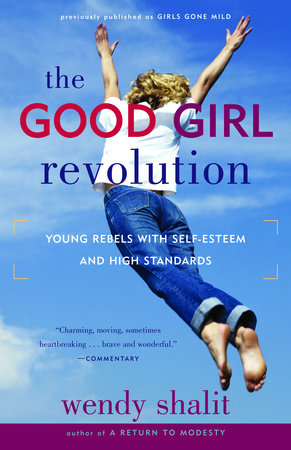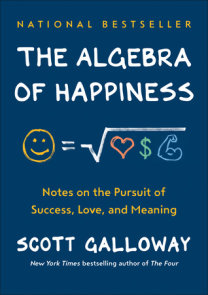READERS GUIDE
In The Good Girl Revolution: Young Rebels with Self-Esteem and High Standards, Wendy Shalit examines a youth-led rebellion that is challenging the status quo. Shalit questions our assumptions about “repressed good girls” and, drawing on numerous studies and interviews, uncovers a new approach towards relationships that values intimacy and trust over sexualexhibitionism.
Questions and Topics for Discussion
1. How do you feel about a coloring book for ages “three and up” that asks young readers what they’d wear to look “hot”, or cartoon characters that sing about the importance of girls looking “hot”? Who benefits from this sexualization of very young girls, and who loses out? Explain.
2. Wendy Shalit says in her Introduction: “For girls to have meaningful choices and genuine hope, the ‘wild girl’ or ‘bad girl’ cannot seem like the only empowered option” (p. xxv). What do you think she means by this statement? The author quotes a teenager who was upset when her fiveyear- old neighbor put on makeup, platform shoes, and a miniskirt to show off in front of some boys playing basketball. But how is the neighbor different from a girl who plays “princess” at home? Why does the author find it problematic that girls at such a young age preen to please boys? Do you agree or disagree?
3. Why might the fifteen-year-old boy involved with a much older woman feel that his mother doesn’t love him because she doesn’t ask where he is going at night (p. 8)? What do you feel is a parent’s role in setting boundaries regarding sexual activity?
4. Are you surprised by the findings, published in The Journal of Sex Research, that many college students are hooking up because of peer pressure and not because these casual encounters are particularly satisfying? How does the author use the concept of “pluralistic ignorance” (p. 11) and apply it to college life? What are college students ignorant of when it comes to hooking up? And why do you think alcohol plays such a large role in these encounters?
5. What evidence does the author present to support her claim that being “publicly sexual” has become the new female ideal (p. 25)? Do you think the popularity of “stripper fitness” and teen magazines glorifying “hot chicks” constitutes a trend, or reflects isolated examples? Do you share the belief that women who wear less clothing are more confident? Why or why not?
6. If a child does not want to take a particular sex education course offered in school, do you think her parent should force her to? Why or why not?
7. How do some teen-advice websites send the message that sexual abstinence is not a valid option? Do you agree with Scarleteen that postponing sex until marriage is not a “manageable” choice (p. 34)? What does the author mean by writing that we have made “a swear word of ‘innocence’” (p. 38)?
8. Why might boys be “scared” of Lauren because she ’s not a “booty call” (p. 42)? Does one have to be sexually active in order to be liberated?
9. Who do you consider to be your role models, and why are they important to you? Do you agree with the fifteen-year-old boy who told Rashida, “Far too often, it’s the adults who are saying we can’t accomplish our dreams, and they expect us to fail instead of encouraging us to aim high” (p. 69)? Are there people in your life who demonstrate that they believe in you?
10. Wendy Shalit claims that nowadays, the desire to connect emotionally to a sexual partner is seen by many to be problematic. “Emotional repression,” as Shalit dubs it, serves to dull feelings of disappointment which often follow “no-strings attached” sex. Do you think that this is a good thing? What do you see as the role of emotion in a healthy sexual relationship? And how do Molly Jong-Fast’s views about sexuality differ from those of her famous mother (p. 105)? Whose views best reflect your own on this subject?
11. The author looks to the past—to the custom of “friendly visiting” (p. 123) in the 1850s, for example—to contrast with those of today’s teenagers, who report that it can be difficult to form lasting friendships. Do you agree or disagree with seventeen-year-old Audrey, who says, “You can’t just go up and talk to somebody because they’re texting on their cell or talking on their cell”? What social changes come to mind when you think of the evolution of technology?
12. Wendy Shalit proposes that our “sexual free-for-all” has made it more difficult to form female friendships and she argues against those who consider adultery to be just another lifestyle choice. Do you agree with the author that if you can’t trust other women, it is more difficult to befriend them? What other factors beyond sexual competitiveness can contribute to the breakdown of friendships?
13. Have you ever considered writing a letter to a business or advertising company, only to think that it wouldn’t make a difference? Why do you think eleven-year-old Ella Gunderson’s letter to Nordstorm was so effective? Given the rash of teen protests against companies that sell racy clothing, do you think sex will always sell with the younger generation, or will there be increasing demand for a bit of mystery and glamour?
14. The danger of overpleasing (p. 180) is an important issue in this book, and the author is troubled by girls who risk their lives with drunk drivers because they don’t want the boys to be “upset.” How does the author distinguish between giving out of love, and pleasing out of insecurity? Brittany Hunsicker (p. 190) is an example of a very traditional yet outspoken teen, having complained to her school board about a “dirty book” read aloud in English class. Do you think the author is right to call her a rebel, or would you consider her more of a pleaser since her parents are traditional? Think of ways in which your own values conflict with what society considers normal, and how you might change things for the better.
15. Shalit cites Helen Grieco, executive director of the California National Organization for Women, who defended the Girls Gone Wild videos because “flashing your breasts on Daytona Beach says, ‘I’m not a good girl. I think it’s sexy to be a bad girl’” (p. 18). Do you think such feminists—who value being “bad”—are typical, or the exception? The author draws a parallel between the new fourth wave of feminists, such as the Girlcotters who boycotted Abercrombie and Fitch’s attitude tees, and the original feminists who believed in women’s power to uplift society. Do you identify with this new fourth-wave feminist, or more with the third wave, which places more emphasis on sexual experimentation? Explain.
16. How do you think adult expectations can worsen the problem of relational aggression (or bullying) or alternatively, help to prevent it?
17. Why would a young woman launch a pornography site as a way of “documenting my life and having people care” (p. 262)? What does this example say about what our society values? And how can parents or friends demonstrate caring so that young people do not have to go to such extremes to feel cared about?
18. Why are people “afraid of the good girl,” according to the author? Do you think that, as a society, we are overcorrecting for the past oppression of women and we have now become too exhibitionistic, or have we struck the right balance? Why does the author find the “sex-negative” versus the “sex-positive” dichotomy to be unhelpful (p. 275)?
19. How do your personal experiences relate to Wendy Shalit’s argument? How do you feel about students who are “sexiled” from their dorm rooms? Coed sleepovers for tweens? The role of pornography in our society and the decline of romance? Parents who pressure their college-age sons to “score,” or their daughters to lose their virginity?




















